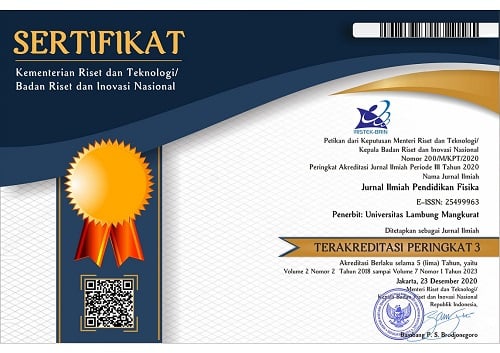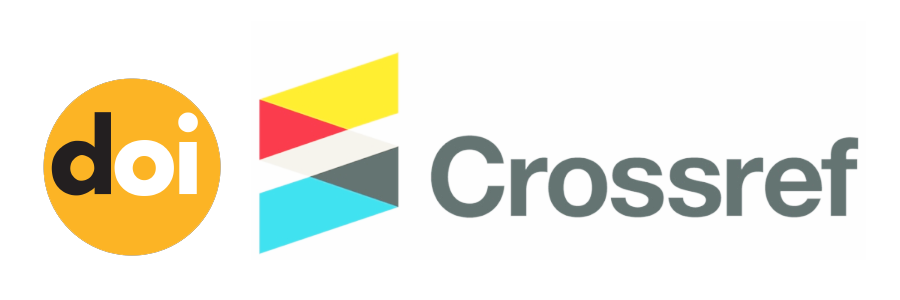Developing A Textbook of Alternating Current Circuit Completed by Solving Problems Using Pythagoras Theorem
Abstract
One of the most difficult chapters in physics is alternating current circuits. This material is also one of the materials tested in the university test. This is because the material requires a fairly complicated mathematical approach. Additionally, the alternating current circuit textbooks that have been used so far still use too high language. Therefore, the researchers need a simple way that can facilitate students in solving alternating current circuit problems and be packaged in a textbook. A simple way to solve alternating current problems can be done using the Pythagorean theorem. This is because the two are identical. Therefore, the purpose of this research is to develop a textbook on alternating current circuit material accompanied by a solution using a simpler method, namely the Pythagorean theorem. This study uses a research and development model with the ADDIE (Analysis, Design, Development, Implementation, and Evaluation) stages. There were five research instruments used: (1) validation sheets; (2) teacher interview sheets; (3) teacher and student needs sheets; (4) test sheets; and (5) student response questionnaire sheets. The developed textbook has been validated by two experts and one user with a percentage value of 89.13%, so it is in the very valid category. In addition, based on the results of field tests on 34 class XII students of Senior High School in Jember, it is known that the developed textbook obtained an effectiveness percentage of 83.46% with an N-Gain value of 83.46. The textbook is in the high category and has a response questionnaire percentage of 80.3, so the developed textbook received a very positive response from students. By using this textbook, students can solve alternating current circuit problems more effectively and efficiently.
Keywords
Full Text:
PDFReferences
Akker, J. V. D., B. Bannan., A. E. Kelly., N. Nieveen, & T. Plomp. (2013). Educational design research. Enschede: Netherlands institute for curriculum development.
Amini, R. (2017). The development of integrated learning based students’ Book to improve elementary school students’ competence. Unnes Science Education Journal, 6 (2), 1586-1592.
Ariani, T. (2019). Efektivitas bahan ajar fisika berbasis cientific materi termodinamika, Jurnal Inovasi dan Pembelajaran Fisika, 6(1), 45–55.
Astalini, Kurniawan, D. A., Perdana, R,& Pathoni, H. (2019). Identifikasi sikap peserta didik terhadap mata pelajaran fisika di sekolah menengah atas negeri 5 Kota Jambi, Unnes Physics Education Journal, 8(1), 34–43.
Defina, D. (2021). BIPA dan MKWK Bahasa Indonesia: Penelitian dan Pengembangan Materi Ajar di IPB. Bogor: IPB Press.
Depdiknas. (2008). Panduan pengembangan bahan ajar. Jakarta: Depdiknas.
Desyandri, D., Muhammadi, M., Mansurdin, M., & Fahmi, R. (2019). Development of integrated thematic teaching material used discovery learning model in grade V elementary school. Jurnal Konseling Dan Pendidikan, 7(1), 16-22.
Diani, R., & Syarlisjiswan, M. R. (2018). Web-enhanced course based on problem-based learning (PBL): Development of interactive learning media for basic physics II. Jurnal Ilmiah Pendidikan Fisika Al-Biruni, 7(1), 105-116.
Fitriah, L. (2019). Efektivitas buku ajar fisika dasar I berintegrasi imtak dan kearifan lokal melalui model pengajaran langsung. Berkala Ilmiah Pendidikan Fisika, 7(2), 82–96.
Hake, H., & Richard, R. (2002). Relationship of individual student normalized learning gains in mechanics with gender, high-school physics, and pretest scores on mathematics and spatial visualization. IUB Physics Education research, 1(1).
Hasyim, F, & Ramadhan, A. (2018). Kecukupan kemampuan matematika bagi calon guru fisika, Jurnal Inovasi Pendidikan Fisika dan Integrasinya, 1(2), 1–6.
Hendriani, N. (2021). Bahan Ajar Sosiologi SMA Berbasis Nilai-nilai Keimanan dan Ketakwaan. Banten: Pascal Books.
Hodiyanto, H. (2020). Pengembangan media pembelajaran berbasis micromedia flash bermuatan problem posing terhadap kemampuan pemecahan masalah matematis, Jurnal Pendidikan Mate,atika, 9(2), 323–334.
Hidayah, D. N., &Priscylio, G. (2019). Pengembangan bahan ajar mandiri pokok bahasan suhu dan kalor menggunakan software Camtasia. Journal of Teaching and Learning Physics, 4(1), 50-64.
Iswara, W., Gunawan, A., & Dalifa, D. (2018). Pengaruh bahan ajar muatan lokal mengenal potensi bengkulu terhadap hasil belajar siswa. JPGSD: Jurnal Ilmiah Pendidikan Guru Sekolah Dasar, 11(1), 1-7.
Koparan, T. (2017). Analysis of teaching materials developed by prospective mathematics teachers and their views on material development. Malaysian Online Journal of Educational Technology, 5(4), 8–28.
Korkmaz, S. D., Aybek, E. C., & Örücü, M. (2016). Special relativity theorem and Pythagoras’s magic. Physics Education, 51(2), 025010.
Mahendra, Z. E., Purwana, U., & Simulation, I. (2022). Pengembangan lkpd digital berorientasi nature of science dan berbantuan phet interactive simulation pada materi gerak harmonik sederhana. Jurnal Ilmiah Pendidikan Fisika, 6(3), 557.
Makki, I, & A. (2019) Konsep dasar belajar dan pembelajaran. Pamekasan: Duta Media Publishing.
Maryamah, I, Anriani, N, & Fathurrohman, M. (2019). Pengembangan bahan ajar materi phytagoras yang berorientasi pada kompetensi abad 21 untuk guru SMP. Supremum Journal of Mathematics Education (SJME), 3(1), 67–77.
Muzijah, R., Wati, M., & Mahtari, S. (2020). Pengembangan e-modul menggunakan aplikasi Exe-Learning untuk melatih literasi sains. Jurnal Ilmiah Pendidikan Fisika, 4(2), 89-98.
Novelensia, N., Bektiarso, S. & Maryani, M. (2021). Penerapan Pembelajaran kooperatif tipe numbered heads together (nht) disertai metode eksperimen dalam pembelajaran fisika di sma. Jurnal Pembelajaran Fisika, 3(3), 242–247.
Nuraini, L., Anggraeni, F. K. A., Harijanto, A., Prastowo, S. H. B., Subiki, S., Supriadi, B., & Wahyu, R. (2022). Development of al-qur'an-based physics learning media applications to improve higher order thinking skills and spiritual attitudes for preservice physics teacher. Indonesian Review of Physics, 5(1), 32-39.
Okun, L. B. (2008). The theory of relativity and the Phytagoras theorem. Uspheki.
Oktaviani, W., Gunawan, G., & Sutrio, S. (2017). Pengembangan bahan ajar fisika kontekstual untuk meningkatkan penguasaan konsep siswa. Jurnal Pendidikan Fisika dan Teknologi, 3(1), 1-7.
Pabri, M., Medriati, R. & Risdianto, E. (2022). Uji kelayakan e-lkpd berbasis kontekstual berbantuan liveworksheet untuk melatih kemampuan berpikir kritis di sma, Jurnal Ilmiah Pendidikan Fisika, 6(3), 642.
Pendidikan, B. S. N. (2016). Lembar Pedoman Penilaian Ujian Praktik Kejuruan Keahlian Teknik Pemesinan Tahun Pelajaran 2016/2017. Jakarta: BSNP.
Permana, A. H., Muliyati, D., Bakri. F., Dewi, B. P., & Ambarwulan, D. (2018). The development of an electricity book based on augmented reality technologies. International Conference on Mathematics and Science Education, 1157.
Permatasari, O. I., & Trisnawati, D. (2021). Pengembangan bahan ajar fisika berbasis way of investigating untuk meningkatkan keterampilan proses siswa smk. Physics Education Research Journal, 3(2), 103-112.
Prabowo, A., Rahmawati, U. and Anggoro, R. P. (2019). Android-based teaching material for statistics integrated with social media whatsapp. International Journal on Emerging Mathematics Education, 3(1), 93.
Ramadhanti, R., Mastuang, M., & Mahardika, A. I. (2020). Pengembangan bahan ajar fisika topik elastistas menggunakan model pengajaran langsung untuk melatihkan kemampuan pemecahan masalah peserta didik. Jurnal Ilmiah Pendidikan Fisika, 4(2), 65-75.
Ramah, S, & Rohman, M. (2018). Analisis buku ajar bahasa arab madrasah aliyah kurikulum 2013, Arabiyatuna: Jurnal bahasa Arab, 2(2), 141–159.
Riduwan. (2015). Dasar-dasar statistik. Bandung: CV. Alfabeta.
Sasmita, S., Medriati, R. & Hamdani, D. (2021). Pengembangan e-modul berbasis process oriented guided inquiry learning materi rangkaian arus bolak-balik (ac) untuk melatihkan kemampuan berfikir kritis siswa sma. DIKSAINS : Jurnal Ilmiah Pendidikan Sains, 2(1), 1–14. doi: 10.33369/diksains.2.1.1-14.
Simarmata, R. K. (2022). Pengembangan bahan ajar dan media pendidikan sd. Tasikmalaya: Perkumpulan Rumah Cemerlang Indonesia.
Suhadirman, S., Damayanti, A, & Syamsudduha, S. (2022). Pengembangan lkpd konsep fluida statis berbasis problem solving polya peserta didik kelas xi ipa SMAN 2 Bulukumba, Jurnal Ilmiah Pendidikan Fisika, 6(3), 616.
Supriadi, B. et al. (2023). Phytagorean theorem for solving simple rlc circuit problems. Proceeding International ICCGANT, 133-145.
Supriadi, B. et al. (2019). Pythagoras method to complete einstein special relativity issues. Journal of Physics: Conference Series, 1211(1).
doi: 10.1088/1742-6596/1211/1/012050.
Supriadi, B. et al. (2022). Respon siswa terhadap metode pythagoras sebagai alternatif. ORBITA: Jurnal Kajian, Inovasi dan Aplikasi Pendidikan Fisika, 8(2019), 128–133.
Tegeh, I. M. & Kirna, I. M. (2013). Pengembangan bahan ajar metode penelitian pendidikan dengan ADDIE model. Jurnal IKA, 11(1), 16.
Tyas, L., Harjana, H., & Wahyuningsih, D. (2020). Identification the need of electronic-based physics teaching materials for increasing problem Solving Ability in the 21st Century. Prosiding SNFA (Seminar Nasional Fisika Dan Aplikasinya), 5, 129-133
Wahyuni, S., & Handhika, J. (2019). Profil kesuliatan belajar pokok bahasan listrik dinamis siswa smk. Makalah Nasional Pendidikan Fisika IV 2018, 7(1), 286–289.
Wini, M. K. M., Laksana, D. N. L., & Awe, E. Y. (2020). Pengembangan bahan ajar multilingual berbasis konten dan konteks budaya lokal etnis ngada pada tema diriku untuk siswa kelas I sekolah dasar. Jurnal Pendidikan Dasar Flobamorata, 1(2), 73-80.
Yulia, E., Asrizal, A., & Ramli (2018). Pengaruh bahan ajar ipa terpadu tema gelombang dalam kehidupan bermuatan literasi era digital terhadap hasil belajar siswa kelas viii smp negeri 8 padang. Pillar of Physics Education, 11(2), 113–120.
DOI: https://doi.org/10.20527/jipf.v7i2.7514
Refbacks
- There are currently no refbacks.
Indexed by: Jurnal Ilmiah Pendidikan Fisika is licensed under a creative commons attribution-share alike 4.0 international license
Statistics Counter |
















